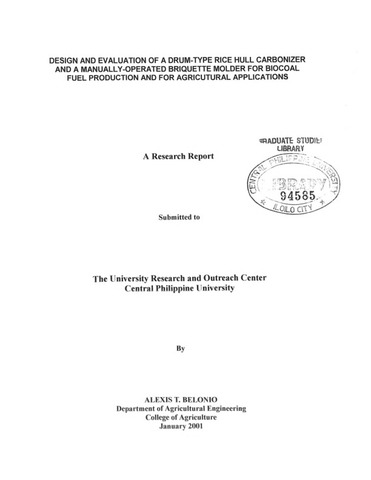Design and evaluation of a drum-type rice hull carbonizer and the manually-operated briquette molder for biocoal fuel production and for agricultural applications
Abstract
A drum-type rice hull carbonizer and manually-operated briquette molder was designed and evaluated to provide rural households a low cost technology that can produce carbonized rice hull (CRH) for biocoal fuel production and for agricultural applications. The study was conducted at the Department of Agricultural Engineering, Central Philippine University, Iloilo City from June 1999 to April 2000.
The carbonizer was made of salvage petrol-drum opened at the top where rice hull is loaded for carbonization. A steel cover with T-chimney was provided to serve as exhaust for burned gases. A 2 ½ - in. electric blower was provided for the carbonizer to supply air necessary for combustion. The drum is elevated by a support stand to facilitate the discharge of CRH. On the other hand, the briquette molder is made of steel pipe having a diameter of 15.5 cm and a height of 13.5 cm. Twelve pieces of 2-cm diameter shafting were centrally distributed in the molder cylinder to create holes on the briquette necessary for proper combustion. The molder can be operated manually by hand pounding the steel press using wooden mallet and by pushing the freshly molded briquette with a counter press.
Results of the test showed that the carbonizer can be loaded with 22.5 to 33.75 kg of rice hull per load. Carbonization time ranged from 43 to 65 minutes to finish one load. The weight of CRH produced ranged from 6.75 to 9.19 kg per load. The average computed capacity of the carbonizer is 31.2 kg per hour with a percentage CRH produced of 30.7%. Each load, an average biocoal fuel of 16 pieces is produced. Molding time per briquette is average to about 1.69 minutes.
Physical properties of CRH produced from carbonizer were found out to be of higher water holding capacity, with 3.49 to 3.72 times of the original weight. Each biocoal fuel weighs about 484.5 to 531.1 g and has a heating value of 2,407.7 kcal/kg. The fuel can be ignited within 2 to 5 minutes and sustain a burning time of 45 to 65 minutes. Two liters of water can be boiled using one piece of biocoal fuel within 21 to 35 minutes.
No significant effect was observed when using CRH as soil conditioner for growing radish. However, the use of CRH as feed supplement for Cobb broiler showed that birds fed with commercial feeds mixed with 5% CRH significantly increase their feed consumption which resulted in an increase in their live weight gain. Calculated return is also higher for birds fed with commercial feeds mixed with 5% CRH.
Cost analysis showed that for an investment cost of P5,700.00 and with a capacity to produce 128 pieces of biocoal fuel per day, the cost to produce a piece of biocoal fuel is P1.80. At a selling price of P3.00 per piece and at an operating period of 8 hours per day, 20 days per month, and 10 months per year, the return on investment is 539 percent. Payback period is 1.85 months and the benefit-cost ratio is 0.65.
Description
Abstract only
Associated Content
Full paper published in PatubasSuggested Citation
Belonio, A. T. (2001). Design and evaluation of a drum-type rice hull carbonizer and the manually-operated briquette molder for biocoal fuel production and for agricultural applications (Research report). Jaro, Iloilo City: University Research Center, Central Philippine University.
Type
Technical ReportSubject(s)
Shelf Location
GSL 630.72 B418
Physical Description
vii, 28 leaves
Collections
- Research reports [167]
- Research reports [37]


